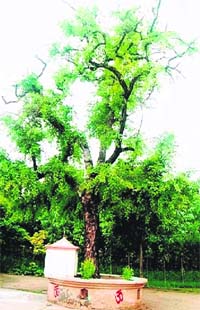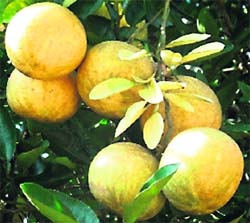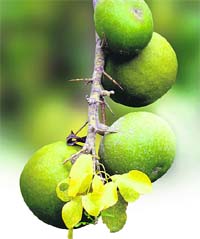|
Society
Boundless benevolence of the bael
The bael tree is an important source of ayurvedic medicine. Its fruit
adds another dimension to its multifarious qualities
Deepak Rikhye
 Conservation
of trees with afforestation were recommended as perhaps the only
solution at the Earth Summit in Rio de Janeiro, Brazil (1992), to
protect the environment. The present rate of deforestation will result
in the loss of approximately one quarter of the world's plant species
within 15 years (IUCN, 1990). In India, our strategy would be to
select different species for different areas. Let us begin an
awareness of trees that thrive in India. If we consider two varieties
of fruit trees, the bael and the wild guava are interesting. Planting
them in mixed stands at parks or existing green belts and other vacant
areas, would be of benefit. Fruit and seed of trees are a major source
of food for birds and certain animals. Both these trees have their
medicinal values which is not always described. They are both
deciduous and therefore will contribute compost and humus to the
adjacent area where they are grown. Conservation
of trees with afforestation were recommended as perhaps the only
solution at the Earth Summit in Rio de Janeiro, Brazil (1992), to
protect the environment. The present rate of deforestation will result
in the loss of approximately one quarter of the world's plant species
within 15 years (IUCN, 1990). In India, our strategy would be to
select different species for different areas. Let us begin an
awareness of trees that thrive in India. If we consider two varieties
of fruit trees, the bael and the wild guava are interesting. Planting
them in mixed stands at parks or existing green belts and other vacant
areas, would be of benefit. Fruit and seed of trees are a major source
of food for birds and certain animals. Both these trees have their
medicinal values which is not always described. They are both
deciduous and therefore will contribute compost and humus to the
adjacent area where they are grown.
The bael tree is an
important source of ayurvedic medicine. Its fruit adds another
dimension to its splendiferous qualities that have prevailed over a
considerable passage of time. Many of us do not live in an arcadian
environment. The gifts of nature are often denied to us; like the bael
fruit. This wonderous fruit is also known by the sobriquet, Bengal
quince. The aegle marmelos is indigenous to the drier regions
of India, extending to Burma. The fact that this tree is deciduous,
results in it shedding its leaves in winter. It has blended into the
flora of the subcontinent. Its trifoliate leaves are used to worship
Lord Shiva, proving yet again that the bael tree has been a part of
India back to a pristine past. Its identity in the North, Bengal,
Orissa and Assam is bael or bel. In the South, it is bilva in Tamil
and bilavamu in Telugu.
 The tree's greenish
white flowers are scented. The globose-shaped fruit has a pulp sweet
to taste, making it a popular juice in summer. In Bengal, it is part
of a delicious cuisine. The tree's greenish
white flowers are scented. The globose-shaped fruit has a pulp sweet
to taste, making it a popular juice in summer. In Bengal, it is part
of a delicious cuisine.
The root, bark and seed
are valued for preparing ayurvedic medicine. The root is part of the Dasmula
or Ten Roots. The Dasmula or Ten Roots denote the roots of ten
different trees which are integral to the formulation of any ayurvedic
preparation. This proves that the bael's properties are omnipresent in
any ayurvadic medicine because the root of this tree is one of the
important ten roots. Medicine from this tree cures melancholia, fever,
and palpitations of the heart.
The fruit has been a
favourite of past generations. In summer, the juice was prepared and
filled into earthenware vessels where it remained amazingly chilled.
The refrigerator was introduced into India in 1927, as a "recent
innovation", (Salim Ali). That was never a problem for the bael.
It shared its bounty all the way back from an unimaginable era.
 The wild guava (careya
arborea) is distributed throughout India and like the bael, to Burma.
A dense and moist forest is what this tree prefers. That explains its
distribution to Sri Lanka. The fact that this tree has an identity in
different parts of India, proves that this species has thrived in the
subcontinent for centuries. In Hindi it is kumb, in Bengali kumbi, in
Tamil, ayma, and in Telugu, Araya. It is a large deciduous tree and
grows to 25metres. It has a thick bark which is dark grey. Its obovate
leaves are large. The 8 cm flowers are attractive in pink and white.
They appear in March-April on leafless branches. The almost globose
fruit is large and green in colour. Each fruit consists of numerous
seeds, with pulp. The fruit is edible and aromatic. The medicinal
value of this tree begins with the bark. A decoction of the bark is
used for treating stomach infections. The leaves are used to treat
ulcers. The bark is a friend to farmers. The inner bark rubbed on
shoes keeps off leeches. The arborea is one of the 5 species of the
genus Careya, found in South Tropical Asia. To revive tree species in
our green belts, or along avenues, we do not need to be confined to
ornamental trees. Any concentration of trees, anywhere, will gift us
with oxygen and reduce the level of carbon dioxide. They will act as
"sink" areas and will absorb industrial gases, thus reducing
air pollution. They will create a better environment. The wild guava (careya
arborea) is distributed throughout India and like the bael, to Burma.
A dense and moist forest is what this tree prefers. That explains its
distribution to Sri Lanka. The fact that this tree has an identity in
different parts of India, proves that this species has thrived in the
subcontinent for centuries. In Hindi it is kumb, in Bengali kumbi, in
Tamil, ayma, and in Telugu, Araya. It is a large deciduous tree and
grows to 25metres. It has a thick bark which is dark grey. Its obovate
leaves are large. The 8 cm flowers are attractive in pink and white.
They appear in March-April on leafless branches. The almost globose
fruit is large and green in colour. Each fruit consists of numerous
seeds, with pulp. The fruit is edible and aromatic. The medicinal
value of this tree begins with the bark. A decoction of the bark is
used for treating stomach infections. The leaves are used to treat
ulcers. The bark is a friend to farmers. The inner bark rubbed on
shoes keeps off leeches. The arborea is one of the 5 species of the
genus Careya, found in South Tropical Asia. To revive tree species in
our green belts, or along avenues, we do not need to be confined to
ornamental trees. Any concentration of trees, anywhere, will gift us
with oxygen and reduce the level of carbon dioxide. They will act as
"sink" areas and will absorb industrial gases, thus reducing
air pollution. They will create a better environment.
It was Lord Buddha who
acknowledged the wonders of trees, saying:
"A tree is a symbol
of boundless benevolence. It goes on giving enormous quantities of
useful materials. It gives shade even to a wood cutter who has come to
cut it".
|